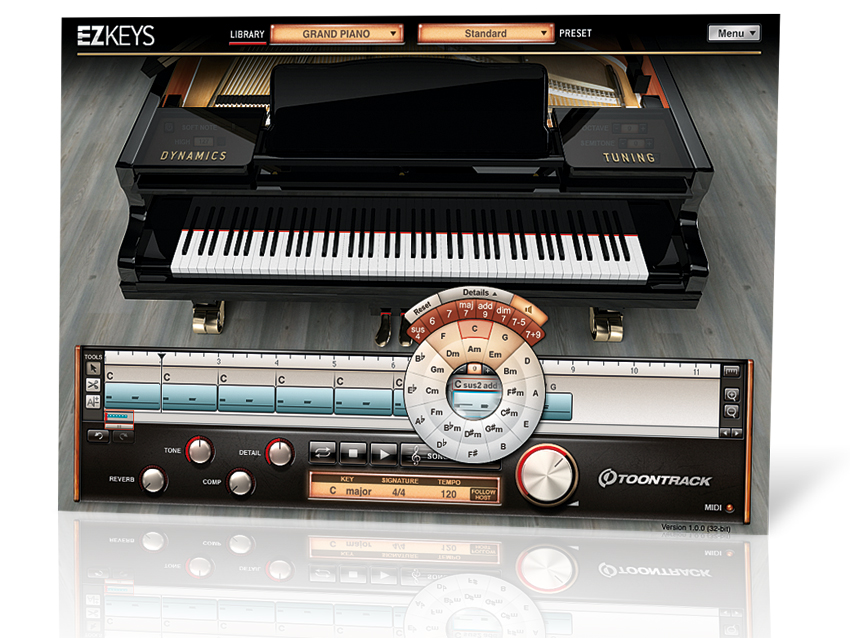MusicRadar Verdict
If you're a songwriter who can't play the piano, EZkeys is flexible enough to bend to your creative will.
Pros
- +
Decent sampled piano; solid selection of MIDI files; great flexibility via Chord Selector; it's certainly EZ!
Cons
- -
MIDI browser is old-school; you only get one piano; the music theory might confuse some.
MusicRadar's got your back
A VST/AU/RTAS instrument that aims to make it easy to create pro-sounding keyboard tracks, EZkeys is the third in Toontrack's EZ range (the first two being 'drummer' and 'mix)'.
This first EZkeys release focuses exclusively on the grand piano - specifically, a 600MB sampled version of the much-loved Steinway Model D. It also comes with a sizeable collection of MIDI files, plus a player that you can load these (and your own MIDI files) into. That, in a nutshell, is it, but the software does have some rather clever tricks up its sleeve.
"It's possible to string together a complete piano track (intro, verse, chorus, bridge, outro) in double-quick time."
We'll get to those in a moment, but first, let's tackle the piano itself. It sounds good, if not mind-blowing.
What it definitely is, though, is simple: you can select an appropriate velocity curve for your MIDI keyboard, adjust the tuning and make edits to the sound using four knobs that change function according to the preset you've selected (eg, the default preset offers Reverb, Tone, Compression and Detail). That's about all there is to it, but given the software's EZ billing, this shouldn't come as any surprise.
No-one's going to choose this piano over the gazillion others on the market on the strength of its tone: the software will stand or fall on the quality and flexibility of its MIDI file content. Fortunately, EZkeys scores pretty well in this area.
Open up the Song Browser and you're presented with a familiar-looking browser that enables you to scan through and preview files in the library. This gives you everything from repeated and broken chords through to song parts in a range of styles (pop/rock, soul, country, gospel, jazz, blues, boogie funk, etc).
Want all the hottest music and gear news, reviews, deals, features and more, direct to your inbox? Sign up here.
Going for a song
While the parts are well-played and reasonably diverse, they're heavily 'songwriter' orientated - great if you're working on material for Adele's next album, but probably not for you if you're looking for the next iconic house piano riff.
These files can be dragged and dropped into the timeline-style Song Track at the bottom of the display, so it's possible to string together a complete piano track (intro, verse, chorus, bridge, outro) in double-quick time. Phrases can be copied/pasted, split and merged in standard sequencer fashion, and completed tracks can be exported or dragged into your DAW.
It's when your song parts are in the Song Track that EZkeys' clever MIDI manipulation features come into play. Each MIDI file is analysed so the names of its component chords can be displayed, and you can then change each of these using the Chord Selector (see The circle of life below for more).
You can transpose song parts, too, though there's no piano roll for note-by-note editing. Your own MIDI files can also be imported by adding folders to EZkeys' browser, enabling you to adjust the key in a similar way.
The circle of life
EZkeys' most impressive feature is arguably its Chord Selector, which enables you to make quick changes to the pitch and sound of any chord sitting in your Song Track.
It's accessed by clicking on any chord name, and has a circular design based on what's known as the circle of fifths. We haven't got space to explain the music theory here, but the basic principle is that each step in the circle takes you a perfect fifth up (or down, if you go anticlockwise). The root chord of the key that you're working in - and its relative minor chord - is in the 12 o'clock position, and chords that naturally 'fit' are highlighted.
Above the circle, another panel enables you to change the flavour of the chord (to a major 7th or sus4, for example). If you click the Details tab, you can even make adjustments on a per-note basis. It's a simple, powerful system that enables you to put your own stamp on your MIDI files.
In many respects, EZkeys feels slick and polished, though in these days of intelligent, time-saving file searching, the strictly hierarchical MIDI browser does feel a little old-hat (you often sense that you're taking a click or two more than you should to get to where you want). What's more, we're a little disappointed that all you get is a grand piano: if an electric piano, Clavinet and organ (plus suitable MIDI files) were included as well, it'd be easier to justify EZkeys' price tag.
As it is, you'll have to wait for the inevitable add-on packs: we're assured that these are coming, but we don't know when or how much they'll cost.
Computer Music magazine is the world’s best selling publication dedicated solely to making great music with your Mac or PC computer. Each issue it brings its lucky readers the best in cutting-edge tutorials, need-to-know, expert software reviews and even all the tools you actually need to make great music today, courtesy of our legendary CM Plugin Suite.

